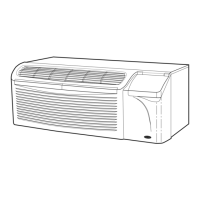52C,P
SERIES
46
MOST FREQUENT PTAC SERVICE QUESTIONS
1. Can remote wall thermostats be used on
standard (AA) models?
No, only for use on remote control (RC,RP) models. How-
ever, accessory RC-Retrofit Kit can be ordered to convert
standard units to RC units.
2. Which remote thermostats are acceptable
for use on 52C,P products?
HH01AD045 — Manual changeover thermostat
TSTATCCBPC01-B (Heat/Cool) — Non-Programmable
thermostat
TSTATCCBPH01-B (Heat Pump) — Non-Programmable
thermostat
TSTATCCPAC01-B (Heat/Cool) — Digital Programmable
thermostat
TSTATCCPHP01-B (Heat Pump) — Digital Programmable
thermostat
3. How many 52C,P series units can be
controlled by one remote thermostat?
Maximum of 4.
4. What is the vent capacity of the
52C,P products?
50 cfm (standalone). Capacity can be increased with the
use of an external exhaust fan.
5. How do the 52C,P series models handle
condensate removal?
By using a 2-stage condensate removal system. First
stage uses a slinger ring to pick up condensate and move
it to the outdoor coil to be evaporated. In second stage, a
vortex pump will suck condensate water into the con-
denser airstream where it will be blown onto the outdoor
coil for evaporation.
6. At what temperature will the outdoor
(defrost) thermostat switch the unit (heat
pumps only) into defrost (emergency heat)
mode?
When the outdoor coil temperature falls below 20 F
(outdoor ambient temperature of approximately 35 F)
and will stay in a passive defrost until outdoor coil is
greater than 35 F.
7. Can the PTAC unit be configured to allow
continuous fan operation?
Yes. A switch located on the front of the control
box is used to toggle between continuous or cycle
fan mode.
8. Can the discharge air grille be changed to
alter the direction of the airflow?
Yes. Remove the 2 screws and flip the grille over
180 degrees.
9. What does the outdoor thermostat
switch do?
The selector screw, located on the front of the control
box, prevents the compressor from energizing in
heating mode during subfreezing conditions to ensure
adequate heating capacity. For units with unit-mounted
controls, the switch must be returned to the ‘‘heat pump’’
position for compressor operation during cooling modes.

